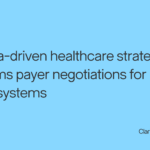As health plans seek innovative strategies to enhance their service offerings and improve financial performance, the integration of telemedicine into their networks emerges as a pivotal solution. By leveraging data analytics to optimize and expand telemedicine capabilities, payers can effectively address the critical challenge of extending quality healthcare to underserved areas while managing costs. This approach not only broadens member bases but also introduces significant operational efficiencies. Here, we will explore how payers can utilize data analytics to effectively integrate telemedicine into their networks, enhancing access to care and promoting financial growth. The use of telemedicine services significantly increased during the pandemic, rising from 15.4% in 2019 to 86.5% in 2021. This surge was driven by the closure of many medical offices and efforts to reduce the number of symptomatic patients seen in person. Later, patients expressed a desire for these services to continue. However, telemedicine has long played a role in expanding access to healthcare for more patients. By integrating telemedicine into underserved areas, payers can attract and retain members who might otherwise have limited access to healthcare services. This expansion not only increases the member base but also leverages efficiency by connecting members to digital services more cost-effectively than physical expansions, enhancing profitability. Additionally, it allows health plans to screen their members for early detection, helping to better manage risk. The most obvious way telemedicine expands access to care is by increasing geographical reach. Data analytics helps payers maximize this reach by identifying underserved areas where telemedicine offerings can help attract and retain members who might otherwise have limited access to healthcare services. Leveraging telemedicine to expand services not only increases a health plan’s member base, but can be more cost efficient and profitable than physician expansions. Analyzing geographic data alongside demographic data enables payers to strategically incorporate telemedicine to fill critical gaps in service. Likewise, telemedicine expands the availability of specialists. There are large areas of the country where access to specialist care is severely limited, and telemedicine allows payers to optimize their network in a way that serves both members and providers. Analyzing data on the demand for various medical specialists helps ensure that the services plans are offering via telemedicine are aligned with membership needs. This is especially important in specialties where there might be a shortage of local providers. Healthcare costs have soared in recent years, and cost-conscious consumers are likely to see telemedicine as a financially attractive option. By promoting telemedicine options, payers can reduce the average cost per patient visit, thus saving on payouts and potentially lowering premiums, making their plans more attractive to cost-conscious consumers. Data analytics enables payers to compare the costs of traditional in-person visits versus telemedicine visits or consultations, helping them better understand utilization and cost. This data can deliver insights into which services are appropriate for telemedicine platforms, and shifting services like routine follow-up care and minor urgent care visits to telemedicine visits can result in potential cost savings. While sick visits and routine care are ideal for telemedicine visits, they can also be a cost-effective option for managing chronic conditions and better administering preventive care. Patient-level data can help identify segments of your membership that would most benefit from telemedicine interventions. Promoting telemedicine as an option to patients who are appropriate candidates, such as those receiving care over long periods of time or for annual preventive care, can reduce the need for expensive emergency care or advanced treatments. Wait times to see a doctor have increasingly gotten longer, with the wait for a new patient appointment increasing to 26 days in 2022. Long wait times can be frustrating for patients, but telemedicine can facilitate quick and easy access to healthcare. Providing timely and convenient care via telemedicine helps payers deliver on the promise of immediate care, increasing member satisfaction and serving as a decisive factor in member retention and attraction. When patients receive care in a timely manner, they are less likely to switch providers, reducing churn and stabilizing revenue streams for payers. Moreover, when providers make more use of telemedicine, it can help streamline claims processing and reduce overhead costs associated with in-person visits. Key to leveraging telemedicine effectively is using data to understand patterns in care delays or unmet patient needs. Once those patterns are identified, payers can integrate telemedicine solutions that offer immediate support, such as virtual urgent care or 24/7 medical advice lines. Data can also provide insights into patient behavior, shedding light on patient appointment compliance or cancellation rates, which helps payers understand which patients are good candidates for telemedicine. Because telemedicine can help improve the timeliness of care by providing more flexible or immediate scheduling options, patients more likely to miss or cancel in-person visits may find telemedicine an attractive option. When members have more access to the care they need, they are more satisfied with their experience. Effectively leveraging telemedicine often results in improved satisfaction ratings and engagement, which leads to increased loyalty and word-of-mouth referrals, both of which can significantly enhance a payer’s market share and competitive edge. Data analytics can provide insights into patient satisfaction scores related to telemedicine and guide improvements in service delivery, provider-patient communication, and overall telehealth experience. Data can also help optimize and customize your telemedicine services and help you ensure offerings meet the specific needs and preferences of a plan’s members. Understanding how different demographics engage with telemedicine positions payers to tailor marketing and educational campaigns to boost the use of telehealth services. Like any other service or provider, the success of telemedicine must be continuously assessed. Through data analytics, payers can review the utilization and outcomes of their telemedicine providers and ensure that their networks are composed of the highest quality providers. Optimally managed networks lead to a better member experience, increased efficiency, and minimal waste, which result in better financial performance. Data analytics also enable payers to negotiate better rates and terms with providers because it shows proof of a leaner, more satisfactory service. Moreover, telemedicine performance data provides insights into outcomes, patient reviews, and adherence to care protocols, which helps payers maintain a high-quality network of telehealth providers. Finally, regularly assessing telemedicine usage and efficacy can help payers decide if they should expand or reduce their services, ensuring that the network remains responsive to member needs and cost effective. Network optimization is essential for enhancing efficiency, reducing costs, and improving the member experience, with telemedicine services being an effective strategy to achieve this. From expanding access to care and enabling payers to reach underserved demographics to reducing overall network costs and to improving satisfaction and engagement, telemedicine holds great promise. To ensure plans are implementing the most effective telemedicine strategy, data-driven insights should be leveraged to determine how to deliver telemedicine services in the way that best serves their membership. Such an approach helps payers meet the needs of their members through telemedicine services and improve their bottom line. How telemedicine can expand access to care
Reducing healthcare costs through telemedicine
Telemedicine supports timely and convenient care
Leveraging telemedicine to improve member satisfaction and engagement
Optimizing network composition and performance
Telemedicine and network efficiency
- Author Details





